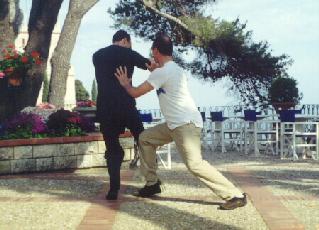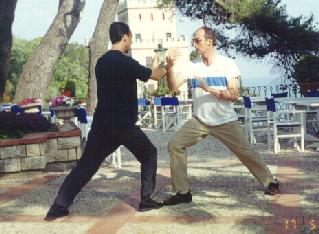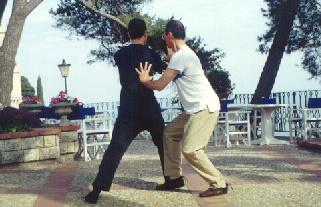TACTIC OF INTERCEPTION
(The Use of Techniques, Tactics and Strategies)

Editorial Note: This is originally meant to be a private webpage for students of Shaolin Wahnam Institute. Nevertheless, as there is not much information on Pushing Hands and Striking Hands although they are crucial aspects of Taijiquan, some explanation is given so that other Taijiquan practitioners may also benefit.
When you have become skilful in applying the tactic of instantaneous counter, you can progress to the tactic of inception. In the tactic of instantaneous counter, you allow your opponent to complete his movement, then you counter-attack instantaneously. The unit of the opponent's movement may be a sequence or a pattern. In the tactic of interception, you intercept his movement at an appropriate time and counter-attack before he completes his intended movement.
There is some innate weakaness in every attack or defend movement. In employing the tactic of interception, the innate weakness is more venerable, especially when the movement you intend to intercept is a feign movement. You must be very sure of both your chance of success as well as your own safety before applying this tactic.
You should also know the likely moves your opponent would make to turn the table round on you when applying interception. You must be ready to abandon your interception at any time when your own safety is at stake. The golden rule in cmbat is "safety first". "Win at all cost" is regarded as silly in kungfu philosophy.

From the initial “peng” position, Roberto moves in with a push.

Instead of moving away, Attilio moves his back left leg diagonally forward to his left side to be at Roberto's back.

Using his back left leg for anchorage, Attilio shoots out his front right leg and simultaneously pushes Roberto flying away.

For someone who is not trained, it would be easy to push him away. But systematic training would enable you to neutralize this attack flowingly, as demonstrated by Roberto above.
Roberto swiftly moves his left back leg diagonally forward to his left, and turns his body to his right to deflect Attilio's push with a "peng" technique. Notice that here, by using a simple movement skillfully, Roberto has changed a previously disadvantageous situation where Attilio was at his back, to a favorable situation where he has opened Attilio's “gate” or defence and is threatening him.

To neutralize the threat, Attilio “threads” his left hand to be at “in-gate”, simultaneously changing into a left Bow-Arrow Stance for better positioning. Here Attilio, by changing his stance and threading his left hand, has reversed the advantageous position. Just before this, he was at a technically disadvantageous position, now he has a technical advantage. To neutralize this, Roberto also changes to the left mode, where his left hand and left stance are in front. Some people call such subtle changes, which many uninitiated students may not realize, the chess aspects of kungfu.
The practice sequence to apply this tactic of interception is shown below in a clock-wise direction.

|

|

|

|
When you are familiar with the skills involved in interception, you may try intercepting other sequences. Later when you are skilful, you can intercept any pattern.
For those who have personally learnt the various sequences of these Pushing Hands techniques from me or their instructors, it is easy to follow the illustrations and explanation, which are meant to remind them of what they did. But for the others who have not learnt them personally, it is difficult to follow the exact movements even with many illustrations and clear explanation.
And here we are concerned with gross external forms. Fine external forms like at what angle you should place your feet, or how much you should turn your body, would be more difficult. Internal aspects like how to sense your opponent and where to channel your energy flow would be unimaginable. This is one of many reasons I have often mentioned that to get good results one has to learn personally from a competent instructor.
Training Points
- The golden rule of safety first.
- Abandon whenever necessary.
- Always make allowance for safe retreat.
- Intercepting sequences and intercepting patterns.
- Excellent against pressing attacks and continuous attacks.
We have learnt four tactics to help us secure advantages in combat, namely
- the tactic of continuous attacks.
- the tactic of confusing attacks.
- the tactic of instantaneous counters.
- the tactic of interception.
In the first two tactics we initiate the first moves to implement the tactics. We therefore have the tactics in mind beforehand. In the latter two tactics we allow the opponents to make the first moves. Hence we do not have the tactics in mind beforehand; we implement them as the opportunites arise.
But we must have the means ready. When an opportunity arises, we do not start thinking what tactics or techniques to use. We just let our preparation flows spontaneously from the opportunity.
Nevertheless when we are fairly advanced we can trick our opponents to fight in the way we want -- without them realizing. This is the use of strategy. For example if we wish to apply the tactic of interception using a particualr sequence of techniques that we have prepared well, we may feign an opening to tempt the opponent to attack. When he offers an opportunity during the attack, we intercepts him and let the prepared sequnce flow from that opportunity.
Terchniques, tactics and strategies form an ascending hierachy. A technique is a particular way to implement an attack or a defence, such as a side kick to the opponent's ribs, or a lowering of the body to avoid the side kick.
A tactic is a creating of situations so as to implement our selected techniques advantageously. For example, if you merely execute a side kick, your opponent can easily defend against it. If he cannot, then he is not a martial artist -- he may be a gymnast or a dancer. But if you pretend to strike his face and while he attempts to defend this strike, you execute a side kick which he fails to defend although he knows how to, then you have successfully used a tactic.
A strategy is a coherent plan to trick our opponents fight in ways favourable for us to implement our selected tactics and techniques. To plan a strategy you have to know yourself well and know your opponent well.
If you just move into a Taekwondo exponent, pretend to strke his face and wait for him to defend your feign move so that you can kick his ribs, you would probably get a kick to your face instead. But if you first tease him, he would probably come in with a kick, or a series of kicks. You move out of his kicking range, but not too far away. While he is panting after a few futile kicks and has become angry, when an opportunity arises, like when he lowers his leg after another futile kick, you feign a strike to his face to distract him but execute a side kick to his ribs. You have used a strategy, and have a good chance to hit him.
Strategies will be discussed later. Having developed some fundamental skills in Pushing Hands or "Tui sou", in the next series, Striking Hands or "Da Sou", we shall learn miore techniques for various types of attack and defence.
Taijiquan Pushing Hands
-
Series 1 -- Basic Techniques and Skills
-
Series 2 -- Front Attacks and Defence
-
Series 3 -- Right Side Attacks
-
Series 4 -- Left and Back Attacks
-
Series 5 -- Continuous Attacks
-
Series 6 -- Confusing Attacks
-
Series 7 -- Instantaneous Counters
-
Series 8 -- Tactic of Interception
Taijiquan Striking Hands
-
Series 1 -- Basic Striking Attacks and Defence
-
Series 2 -- Seeking Advantages in Striking Attacks
-
Series 3 -- Basic Kicking Attacks and Defence
-
Series 4 -- Seeking Advantages with Kicking Attacks
-
Series 5 -- Felling Attacks and Defence
-
Series 6 -- Reversing Falls
-
Series 7 -- Gripping Techniques
-
Series 8 -- Counters against Gripping Attacks
LINKS
